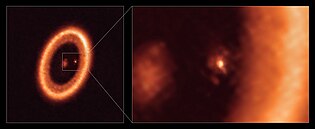
A circumplanetary disk (or circumplanetary disc, short CPD) is a torus, pancake or ring-shaped accumulation of matter composed of gas, dust, planetesimals, asteroids or collision fragments in orbit around a planet. They are reservoirs of material out of which moons (or exomoons or subsatellites) may form.[1] Such a disk can manifest itself in various ways.
In August 2018, astronomers reported the probable detection of a circumplanetary disk around CS Cha B.[2] The authors state that "The CS Cha system is the only system in which a circumplanetary disc is likely present as well as a resolved circumstellar disc."[3] In 2020 though, the parameters of CS Cha B were revised, making it an accreting red dwarf star, and making the disk circumstellar.[4]
- ^ Parks, Jake (8 November 2021). "Snapshot: ALMA spots moon-forming disk around distant exoplanet - This stellar shot serves as the first unambiguous detection of a circumplanetary disk capable of brewing its own moon". Astronomy. Retrieved 9 November 2021.
- ^ Ginski, Christian (August 2018). "First direct detection of a polarized companion outside a resolved circumbinary disk around CS Chamaeleonis". Astronomy & Astrophysics. 616 (79): 18. arXiv:1805.02261. Bibcode:2018A&A...616A..79G. doi:10.1051/0004-6361/201732417.
- ^ Starr, Michelle. "Astronomers Have Accidentally Taken a Direct Photo of a Possible Baby Exoplanet". Retrieved 10 October 2019.
- ^ Haffert, S. Y.; Van Holstein, R. G.; Ginski, C.; Brinchmann, J.; Snellen, I. A. G.; Milli, J.; Stolker, T.; Keller, C. U.; Girard, J. (2020), "CS Cha B: A disc-obscured M-type star mimicking a polarised planetary companion", Astronomy & Astrophysics, 640: L12, arXiv:2007.07831, Bibcode:2020A&A...640L..12H, doi:10.1051/0004-6361/202038706, S2CID 220525346